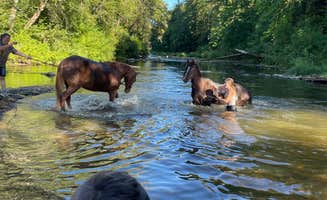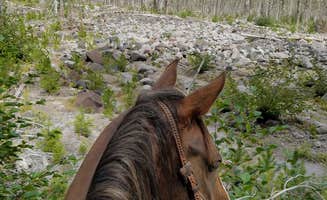Equestrian camping near Kelso, Washington offers access to the Cascade foothills and extensive trail networks throughout southwestern Washington's temperate rainforest region. The area receives approximately 50 inches of annual rainfall, creating lush, forested camping environments with temperatures averaging 45°F in winter and 65°F in summer. Campsites range in elevation from 200 to 2,500 feet, with varying terrain suitable for both novice and experienced trail riders.
What to do
Trail riding on Liahona Trail: Camp Wilkerson provides extensive riding trails just 45 miles from Kelso, with interconnected loops suitable for day rides. "This is a primary horse camp and is surrounded by trails, seen a heard of elk on one of my hikes," reports Guy S. from Camp Wilkerson.
Mount St. Helens exploration: Riders can access trails with volcanic views from Kalama Horse Camp. "There are several awesome trails you can take right from the campground and there is a campground trail that guides you around the whole campground area," notes Kelcie T. about Kalama Horse Camp. The trails offer scenic views and access to higher elevation routes.
Forest bathing on old-growth trails: Lewis and Clark State Park features mossy trails through ancient cedars. "Beautiful, quiet, extraordinarily well maintained... Add the easily accessible trails, one through one of the last standing groves of old growth forest," writes Janet S. about her experience at Lewis & Clark State Park Campground.
What campers like
Spacious equestrian sites: Dedicated horse areas provide ample room for trailers and tack. "Each spot is large and quite private. The sites are nice and close to a creek which was nice since it was hot," explains Jessica C. about Kalama Horse Camp Campground.
On-site corrals and facilities: Many campgrounds provide built-in horse infrastructure. "Most all of the campsite have horse corrals... There is stock water and wheelbarrows for mucking," shares Mari R. about Kalama Horse Camp, noting the equestrian-specific amenities that make camping with horses easier.
Wildlife viewing opportunities: The area's forests support diverse wildlife populations visible from trails. "Great views up on the high trails of the mountains. We enjoy it and go at least annually!" adds Mari R. about the scenic vistas available to equestrian campers at Kalama Horse Camp.
What you should know
Seasonal access limitations: Trail conditions vary significantly with weather. "Like most campgrounds, it has its peak season and its off-season, but you can go there year-round if you choose to," explains Richard B. about Battle Ground Lake State Park Campground.
Campsite reservation requirements: Many equestrian sites require advance booking, especially during summer. "If you do not reserve your spots you can only stay one night and there is an additional $5 transaction fee to pay on site," cautions Schona K. about Camp Wilkerson.
Water quality concerns: Some campgrounds experience periodic water issues. "I did encounter a slight concern with using this bathhouse because there was a current e coli water warning which was displayed throughout camp on all water spigots," notes Crystal C. about Lewis and Clark State Park.
Trail maintenance varies: Some trails require volunteer upkeep. "Trails are in abundance and usually maintained by volunteers and USFS," explains Mari R., highlighting the community involvement in keeping horse trails accessible.
Tips for camping with families
Multi-use recreation areas: Some parks combine horse camping with family activities. "They have a large shelter used for weddings. Adirondacks that didn't seem used much, a tent camping area and cabins... It's a decent basic campground with a small stream running through it," shares Ashley Y. about Camp Wilkerson.
Educational opportunities: Many parks offer interpretive programs. "At night the campground had a great Junior Ranger program with a very enthusiastic park ranger that kept the almost 50 people/kids entertained. She was great at engaging all the kids and teaching them about the park," recommends Ashley B. about Seaquest State Park.
Swimming and fishing access: Lakes provide alternative recreation. "They have a cool volcanic lake with a swimming area and great fishing. Its like a mini crater lake. I mean mini like pond size," describes Ashley Y. about Battle Ground Lake, noting the diverse activities available beyond horseback riding.
Playground facilities: Some campgrounds include play equipment. "My kids loved the addition of a playground. Many parks dont have this and it kept them entertained for hours," shares Mary C. about Seaquest State Park Campground.
Tips from RVers
Horse trailer parking specifications: Equestrian sites typically accommodate larger rigs. "Great for groups... The shelters were perfect for sliding a tent in with bunks even. Great trails near," notes Kayden G. about Dairy Creek West — L.L. Stub Stewart Memorial State Park, indicating the flexible accommodations available.
Utility connections for extended stays: Full hookups available at select equestrian campgrounds. "We stayed at a full hook up campsite that included electricity sewer and freshwater," explains Theresa R. about Lewis & Clark State Park Campground, detailing the amenities available for RV campers.
Site privacy considerations: Campground layouts affect the camping experience. "While it's open, for the most part you do have a limited amount of privacy in the campground," notes Richard B. about Battle Ground Lake State Park, addressing a common concern for RV campers sharing space with others.
Shower and restroom access: Facilities vary widely between campgrounds. "The lower bathroom is old and needs updated. The showers are free but the water just sprays everywhere and you have to keep pushing the button for more water. The upper bathrooms are amazing and worth the walk near the horse camp," advises Schona K. about Camp Wilkerson.




